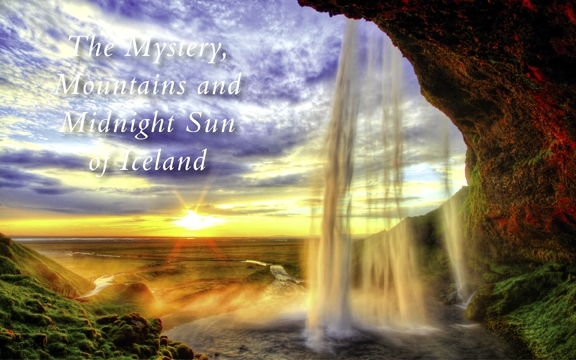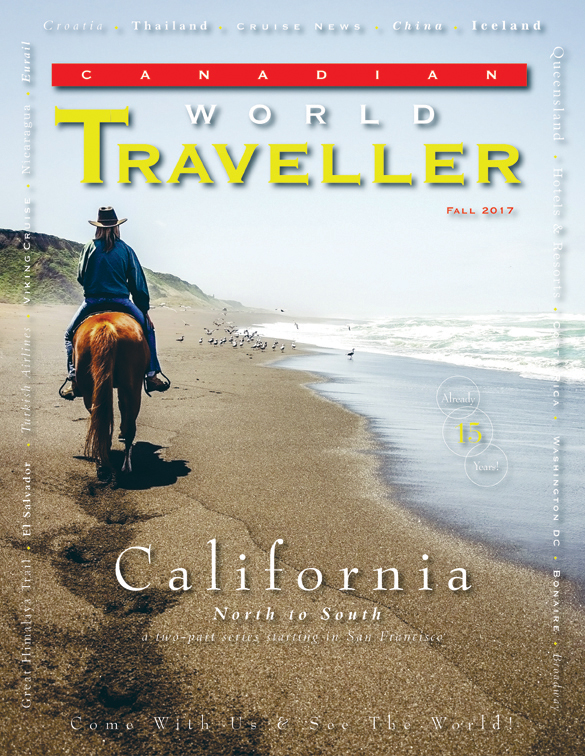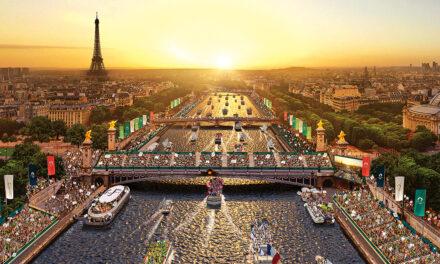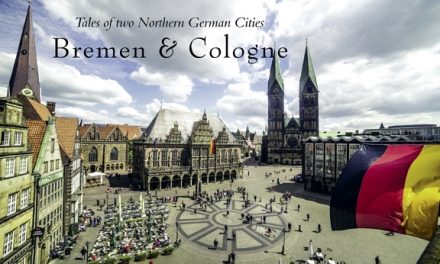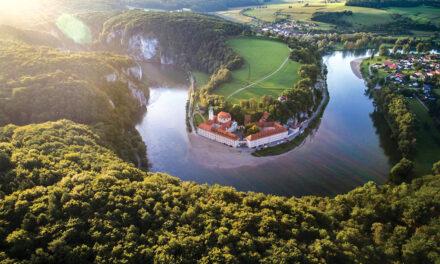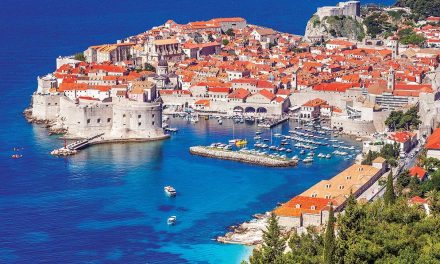Iceland
The Mystery, Mountains and Midnight Sun of Iceland
by Anne-Marie Macloughlin
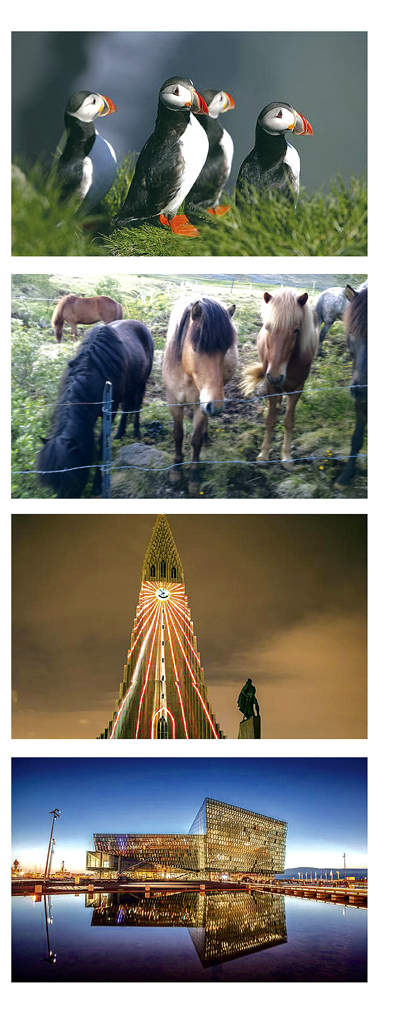
Iceland has seen a huge boom in tourism in the past year, with projected figures for 2017 in the region of 2 million visitors, according to The Iceland Monitor, an English language news and information site (http://icelandmonitor.mbl.is). In spite of high prices and erratic weather, especially in the summer, Iceland is a hot spot, both literally and figuratively.
There are few places on earth that compare to Iceland, its dark winters countered by 24-hour daylight in Midsummer, and it was this that drew me from muggy Toronto to this windswept and wild Nordic paradise. Where else would one experience the Summer Solstice if not in the Land of the Midnight Sun?
Five and a half hours flying time from Toronto and I was landing on a wet and windy runway at Keflavik Airport, small but with a substantial selection of duty-free goods. Iceland has the distinction of allowing travelers the option to purchase duty-free on arrival, so bear this in mind if you wish to sample local liquor while there (more on that later).
Bus transfers to and from Keflavik are frequent, tickets around 2500 ISK (Approx $30). Many vendors also take Euros, with the bus station souvenir shop and café also accepting foreign currency (useful if you fancy a serving of sheep’s head stew while waiting). Be aware that you
receive your change in Icelandic Krona which can be baffling to those having difficulty making the conversion. Carry a calculator to avoid frantic math while tolerant vendors wait.
Language
The Icelandic language is Nordic in the extreme, evoking romantic heroes and ancient Gods. I met more than one Þor (Thor) while visiting, captivated by the use of the Old Norse letter Þ, pronounced like ‘th’ in English. Icelanders are mostly fluent in English; they do, however, appreciate non-natives attempting to get to grips with simple phrases and are understanding of the fact that outside the 300,000+ residents of this small island, it is not widely spoken.
Good morning – Góðan daginn. (Goh-than da-yin.)
I don’t understand – Ég skil ekki. (Yeh skil eh-ki.)
Do you speak English? – Talarðu ensku? (Ta-lar-thu en-sku?)
I don’t speak Icelandic – Ég tala ekki íslensku (Yeh ta-la eh-ki ees-len-skuh)
The latter phrase has been cheekily parlayed into a popular tourist gimmick, popping up on t-shirts in the many gift shops on Reykjavik’s main street, Laugavegur, and the website idontspeakicelandic.com. But to truly impress your friends (and the locals), learn how to say Eyjafjallajokull – “ei-ya-fyat-LA-yer-kut-le”. This mighty volcano stopped air traffic over Europe in Spring 2010 and stumped many newsreaders trying to get their tongue around the name.
Urban Hiking in Reykjavik
Nestled in the Seltjarnarnes peninsula with mighty Mt. Esja standing guard over it lies the capital city of Reykjavik. The world’s most northern capital city, it’s the perfect size to spend an afternoon exploring, its gentle hills and pretty views reminding travellers that we are not far from nature. Summer has erratic temperatures, however, and the week I was there it rained non-stop, the highs around 12C, so be prepared to find alternatives to bathing in the theoretical sun. The main bus depot at Hlemmur sits at the tail end of Laugavegur, the city’s main street.
Reykjavik has several museums but the one that stands out has to be the Phallalogical Museum (phallus.is). The only one of its kind, the exhibit is comprised of phallic specimens from animals indigenous to Iceland – including homo sapiens. If that’s too much to assimilate one is able to enter the gift shop separately.
One of the complaints the average traveler has about Iceland is the high cost of, well, everything. There are ways around this; self-catering and packing a lunch is a lot cheaper than eating out. To get an idea of how expensive food is, an Ikea-style street dog will run at around $7 (sans fancy toppings), and a tea/coffee $5/6. When the locals consider 2000ISK (around $24) for a bowl of noodles cheap, you know you’re not in Kansas anymore. That said, where else can you get to sample puffin, whale and shark on the same menu?
The local grocery stores are a tourist’s best bet for some local fare and souvenirs that won’t break the piggy bank. Look out for Bonus, the store with the pig logo (Laugavegur 59 and others). I picked up some salty fish roe spread in a tube and flatbread with moss for around $6.
Cod liver paté in a cute tin makes for an authentic Icelandic gift for the folks back home; also don’t forget the salty liquorice candies so loved by Scandinavians.
There are many free attractions and photo opps too. Faxafloi Bay is just down the hill from Laugavegur with the glittering cube of the Harpa concert hall jutting into the bay. Hosting the opera, ballet and more, this modern masterpiece is free to enter, the ubiquitous gift store a little more upmarket than the stores of Laugavegur. Take a walk along the shoreline to the Sun Warrior sculpture, a favourite subject for photographers.
One cannot miss the opportunity to visit Hallgrimskirkja, a modern church resembling a glacier jutting out of the landscape. At 244ft high, there is an observation deck if you enjoy heights. Be aware that the church does not have a public bathroom; in fact downtown Reykjavik is WC-challenged apart from the odd vintage-looking cylinders dotted around. Similar to those in Europe, they don’t cost a Krona and are self-cleaning. The ones I visited had plenty of bathroom tissue and weren’t too pungent but it doesn’t hurt to always be armed with some Kleenex if you’re not a fan of the rough stuff.
Ask any Icelander what they dislike about tourism and they’ll likely mention the overpriced bags of candy masquerading as “Puffin Poop” or “Lava Rocks”, given that the same candy is available in Bonus for a fraction of the price in its generic wrapper. If it’s a piece of Iceland you’re after, many of the stores sell locally-made soap that contain birch, glacial water or actual volcanic ash from Eyjafjallajokul (the latter, a robustly gritty exfoliating bar). Avoid the Icelandic coins and lava rocks masquerading as fridge magnets at prices that would blow a geysir.
After a few hours of walking refreshments are in order. Alcohol is expensive, so the savvy tourist will make the most of the Duty Free at Keflavik or research the bars that have Happy Hour deals. Many have live music with the tail end of Happy Hour coinciding with the entertainment. Dillon Whiskey Bar has 2 for 1 specials which amount to around $14 for two pints of local brew, the patio a sweet sanctuary from the downtown grind. I was fortunate enough to experience Drink and Draw night at Hurra! Bar, paper and pencils provided to the patrons to get artsy with strangers and invoke your inner child. A high point of the trip, it was simplicity itself to strike up a conversation with others and talk art, culture and beer. The event moves around to other bars so check listings.
Note: Shots of Brennivin (the famous Icelandic schnapps also known as the Black Death) will set you back more than $10 in a lot of bars, so do as I did and bring some home to share with your bestie.
When you plan on taking a rest from the grind of everyday life, Iceland is hard to top. Uncongested, environmentally responsible and welcoming to visitors, the vibe is restorative, calm and pensive. Trapped in the construction hell that is Toronto every summer, this escape was especially profound. I climbed a mountain, made friends with Icelandic horses, and learned to slow down. For that alone, it was priceless.
www.iceland.is
Click on cover to view published article

